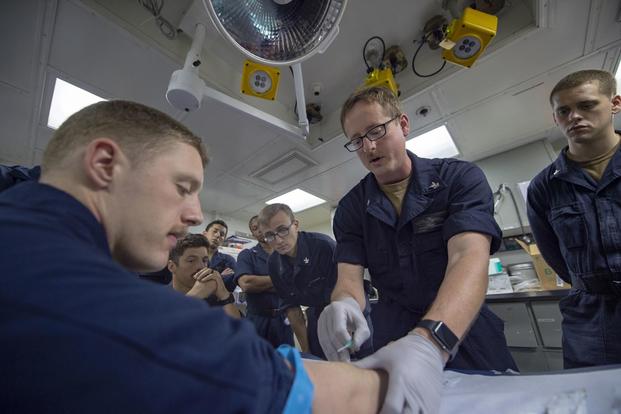Patients at military hospitals and clinics can expect to see far fewer uniformed doctors when they go for appointments on base under a Defense Department plan to convert thousands of uniformed health care billets to civilian positions.
President Donald Trump's proposed fiscal 2020 DoD budget introduces a proposal to eliminate "roughly 15,000" uniformed health care jobs within the services, converting them to civil service positions.
The effort is part of an overall modernization strategy for the military health system, Pentagon officials said Tuesday while unveiling the department's $545 billion proposed base budget.
The budget includes $49.5 billion for military health, down 2.3 percent from the fiscal 2019 enacted budget, largely from a planned reduction in the number of military personnel assigned to the Defense Health Agency.
Related content:
- More Than 17,000 Uniformed Medical Jobs Eyed for Elimination
- Use Scalpel, Not Cleaver, on Medical Billets, USUHS Chief Urge
Deputy Under Secretary of Defense Elaine McCusker, the Pentagon's comptroller, said the billets -- physicians, dentists, nurses, corpsmen, medics and administrative staff -- would transition to civilian jobs "to put those military billets back into lethality."
She added that the effort is part of health care reform intended to "deliver the same quality of health care but doing it a little more smarter and more efficient."
She declined to give specifics on the exact number of billets that would be converted, mentioning the 15,000 figure, or the types of jobs involved.
According to budget documents, the proposal represents "the most significant review of the military medical end strength portfolio since fiscal 2003."
The revised allocations were determined by the services, the Joint Chiefs of Staff and the Office of the Secretary of Defense to "more adequately determine the wartime requirements for the medical force," the documents noted.
"The resulting reduction in active-duty military medical providers will ultimately provide a medical force appropriately sized and shaped to meet National Defense Strategy requirements and will allow the military health system to optimize operational training and beneficiary care delivery," according to the documents.
To some, however, the proposal to reduce uniformed staff by as much as 13 percent is worrisome. Retired Army Maj. Gen. Richard Thomas, an ear, nose and throat surgeon who serves as president of the Uniformed Services University of the Health Sciences, said the conversions must be made surgically.
"After the end of every major combat window, you tend to downsize the force somewhat. There's a certain amount of health in that," Thomas told Military Update in February.
But he warned against making deep cuts that might affect medical services and capabilities.
Analyzing the effect of such cuts on the ability to perform the mission "is really what the services' medical departments are for. They need to take that and do the analysis," Thomas said. "They may come back and say, 'Hey that number's too large. I can't do it.' But I also think they are going to have to snap link this to a timeline. 'If you want me to attrite certain specialties or personnel numbers, how many of those then become civilians?'"
The Defense Department health system includes 49 hospitals, 427 clinics, 246 dental clinics, operational field units and all associated personnel. In addition to the reduction in the number of military billets, other systemic reforms are underway, to include transferring management of all medical facilities to the Defense Health Agency, or DHA.
Since Oct. 1, 2018, 31 medical facilities have transitioned to the DHA, with an additional 241 -- mainly military treatment facilities in the eastern U.S. -- transferring under the DHA in fiscal 2020.
Also in 2020, military health facilities will see the continued rollout of the MHS Genesis, the department's electronics health records system. Facilities expecting to receive the new interoperable system include Naval Medical Center San Diego and Naval Hospital Camp Pendleton, California; Elmendorf Air Force Base and Fort Wainwright, Alaska; Fort Carson, Colorado; and Fort Leavenworth and Fort Riley, Kansas.
-- Patricia Kime can be reached at Patricia.Kime@Military.com. Follow her on Twitter at @patriciakime.












